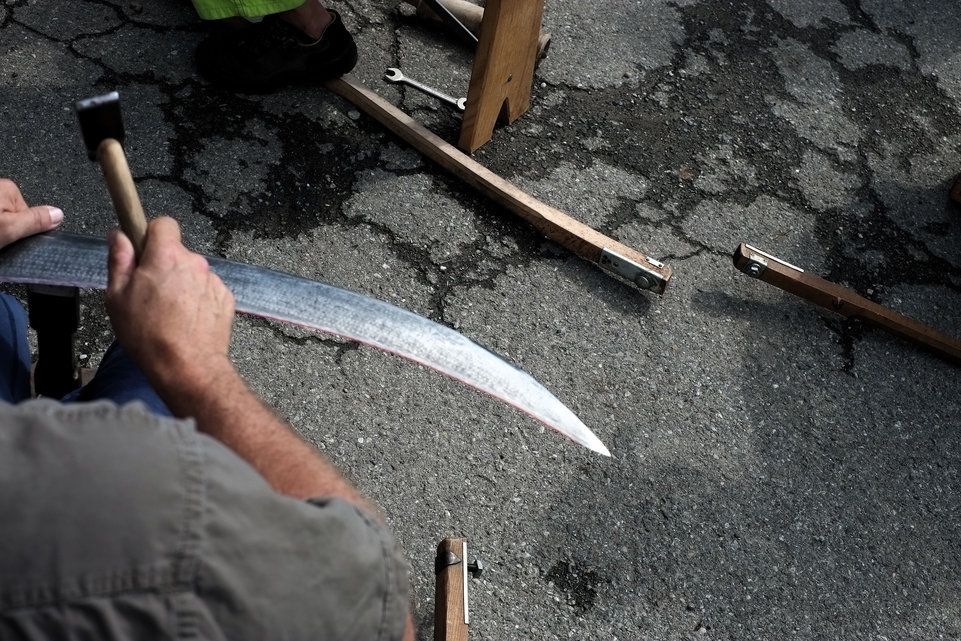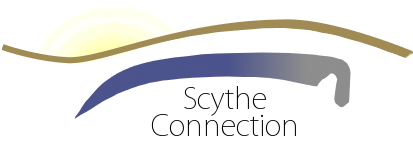 |
| Parks employees get scythe training in Vevey, Switzerland. From the video "La faux: Un outil réhabilité" by Ville D'images, Vevey.tv |
Prior to the widespread adoption of motorized brushcutters and string trimmers, scythes were commonly used for the maintenance of roadsides, parks, and other public spaces. In recent years, there has been a resurgence in the use of scythes by parks departments and public works employees.
The well-developed nation of Switzerland is at the forefront of this movement "backwards", judging by the documentation available online. Among the Swiss cities that employ scythes are Zurich, Geneva, Lausanne, Luzern, and Vevey.
The reasons given for re-adopting the low-tech scythes are not limited to the scythe's virtues as a non-polluting "green" solution. Scythes also have performance-related advantages over the motorized alternatives, and these advantages are being recognized.
City workers in Zurich, led by Andreas Hochstrasser, are using scythes to help them maintain the green spaces within the city environment. According to Hochstrasser, scythes have the following advantages over motorized trimmers and brushcutters:
- Scythes were found to be faster in trials.
- The relatively quiet scythes can be used at times when noisy equipment is not allowed.
- Scythes require a minimal safety distance, while brushcutters require a 15m radius.
- Despite precautions, the city was spending thousands of francs each year to compensate for property damage done by the brushcutters (typically damage to windows and cars); the scythes result in no damage.
- When scythes are used, dog droppings do not become airborne.
- Damage to tree trunks does not occur with scythes.
- Scythe-cut material can typically be removed easily with a pitchfork. A leaf blower is typically used to clean up after the motorized cutters.
In Geneva, Jean-Gabriel Brunet is responsible for the maintenance of green spaces in the city, and thirty of his workers have attended training in the use of scythes. Brunet and his crew added a few more advantages that scythes have over motorized trimmers:
- The scythe is more effective than a mower or trimmer in places difficult to access.
- On banks, a worker can cut 200m in one hour with a scythe, while cutting only 135m with a trimmer.
- With a trimmer, everything is chopped up: grass, seeds, insects. With a scythe, the grass is long, the seeds can fall and germinate, and the insects are preserved.
- The grass cut with a scythe can be retrieved to use as hay for animals.
- The scythe is non-polluting.
- The 15m safety distance for a trimmer is reduced to only 1m for a scythe.
- Fatigue is less with a 1-2 kg scythe, compared with an 8-10 kg trimmer.
- With a scythe, you can work for hours, and then go dancing that night!
 |
| In Geneva, city workers get training in scythe maintenance. Note the method of blade attachment. [Photo by Oliver Vogelsang] |
The city of Lausanne has also reintroduced the scythe for maintaining its parks and green spaces. After 40 city gardeners were instructed in 2009, the city opened the training to the public, and a scythe course has been held every year since then. Besides the advantages of scythes already listed above, the city of Lausanne gives some more reasons why scythes are preferred over the motorized trimmers:
- No vibrations with a scythe.
- No breathing exhaust fumes with a scythe.
- Scythes consume only elbow grease.
Scythe usage is being promoted throughout Switzerland by the organization VSSG/USSP (Swiss Union of Parks and Recreation Services). The VSSG/USSP offered a scythe course in Luzern for city employees who are "tired of the brushcutter". After the training, participants concluded that "mowing with a scythe is more than just tradition and nostalgia. It is a fast, environmentally friendly and healthy craft".
The VSSG/USSP also held scythe training in the city of Vevey. The courses were offered to parks employees who wanted to learn how to use a scythe for cutting meadows and slopes, instead of using mechanical methods. A video was made during the 2010 training in Vevey:
Looking beyond Switzerland, Peter Vido describes (at ScytheConnection.com) how scythes have been reintroduced at a town in Austria:
Until [1997], the traditional scythes were standard equipment in the pick-up trucks of all road maintenance crews in the township of Grieskirchen, Austria. They were used for cutting grass on steep and often irregular embankments, around electricity and telephone poles, trees, bushes and ornamental shrubs. Large open areas are mowed by means of specially designed trucks mounted with cutting and grass pick-up devices.
In 1997 the traditional scythes were replaced with a modern, though still hand-held version, referred to in German as "Motorsensen" (motor scythe). (This is not a mere string trimmer but a considerably more rugged alternative with actual steel blades powered by an engine.)
However, in due time maintenance personnel found several disadvantages of this new equipment: noise, vibrations, the need for protective gear, and actually lower efficiency than was the case with a conventional scythe! That realization inspired comparative tests in which typical task were performed with both tools. The results showed that the output of a man with the traditional scythe was about twice that of one using the "motorsense". Besides, he was more comfortable while working. Consequently, [around 2003] the equipment of the road maintenance trucks was changed back to conventional scythes.
At present only a single team uses a power scythe, due to a temporary lack of knowledge in use and care of a scythe blade. Some older maintenance people are part-time farmers with good skills in scythe use, but for younger people, training could be useful in order to keep up the use of scythes.
Until [1997], the traditional scythes were standard equipment in the pick-up trucks of all road maintenance crews in the township of Grieskirchen, Austria. They were used for cutting grass on steep and often irregular embankments, around electricity and telephone poles, trees, bushes and ornamental shrubs. Large open areas are mowed by means of specially designed trucks mounted with cutting and grass pick-up devices.
In 1997 the traditional scythes were replaced with a modern, though still hand-held version, referred to in German as "Motorsensen" (motor scythe). (This is not a mere string trimmer but a considerably more rugged alternative with actual steel blades powered by an engine.)
However, in due time maintenance personnel found several disadvantages of this new equipment: noise, vibrations, the need for protective gear, and actually lower efficiency than was the case with a conventional scythe! That realization inspired comparative tests in which typical task were performed with both tools. The results showed that the output of a man with the traditional scythe was about twice that of one using the "motorsense". Besides, he was more comfortable while working. Consequently, [around 2003] the equipment of the road maintenance trucks was changed back to conventional scythes.
At present only a single team uses a power scythe, due to a temporary lack of knowledge in use and care of a scythe blade. Some older maintenance people are part-time farmers with good skills in scythe use, but for younger people, training could be useful in order to keep up the use of scythes.
SOURCES:
Zurich
"La faux: supérieure à la débroussailleuse portable", by Andreas Hochstrasser and Peter Stünzi, VSSG/USSP, 2006
http://www.vssg.ch/documents/vtxt1/FR/La_faux.pdf
Geneva
"Les faucheurs sont de retour dans les parcs genevois", by Sophie Roselli, Tribune de Genève, 27.07.2012
http://www.tdg.ch/12125272/print.html
Lausanne
"Le retour du fauchage à la faux dans les espaces verts lausannois"
http://www.lausanne.ch/thematiques/nature-et-domaines/politique-ecologique/actions-emblematiques/fauchage-a-la-faux.html
"Cours de fauchage à la faux «Edition juin 2013»"
http://www.lausanne.ch/thematiques/nature-et-domaines/produits-et-prestations/cours-et-formations/cours-de-fauchage-faux.html
VSSG/USSP
Vereinigung Schweizerischer Stadtgärtnereien und Gartenbauämter
Union Suisses des Services des Parcs et Promenades
http://www.vssg.ch/xml_1/internet/fr/application/d162/f163.cfm
Luzern
"Mähen mit der Sense", VSSG/USSP, Peter Stünzi, Director, 2012
http://www.vssg.ch/documents/Kurs_Ausschr_Maehen_Sense_20120619.pdf
"Mähen mit der Sense, Kurs in Luzern, Kurzbericht", by Thomas Schmid
http://www.vssg.ch/documents/Maehen_Sense.pdf
Vevey
"La faux: Un outil réhabilité", video by Ville d'images, vevey.tv, 19.06.2010
http://www.vevey.tv/zapping/vie-locale/130-la-faux-un-outil-rehabilite
Grieskirchen, Austria
"Biodiversity and the Scythe", by Peter Vido, ScytheConnection
http://scytheconnection.com/biodiversity-and-the-scythe/
http://www.scytheconnection.com/adp/biodiv/austria.html
UPDATE: See subsequent post "Scythes and the City"







